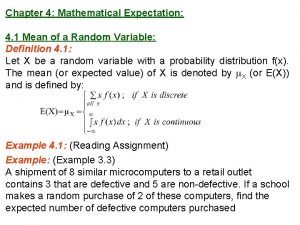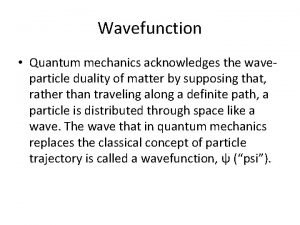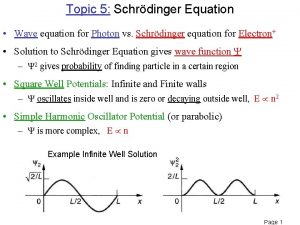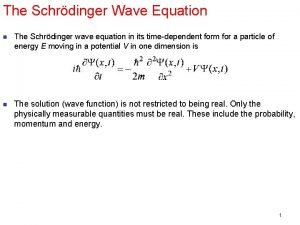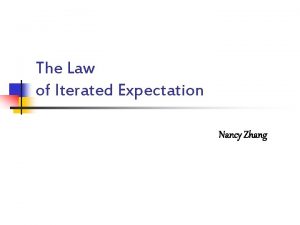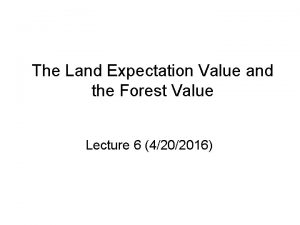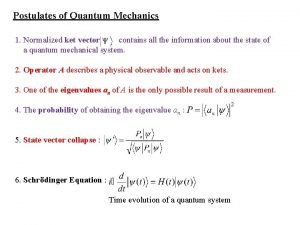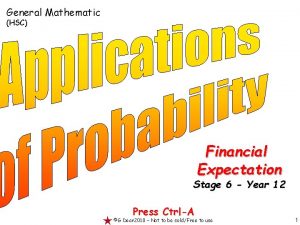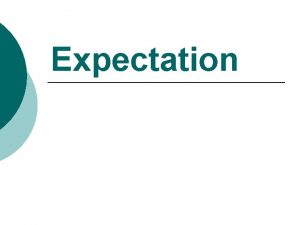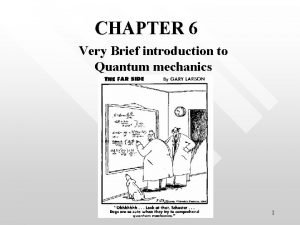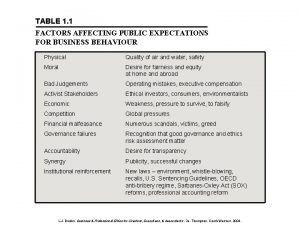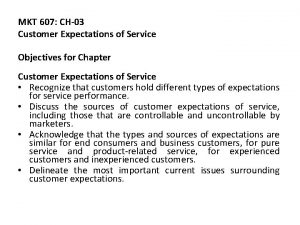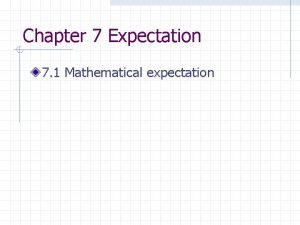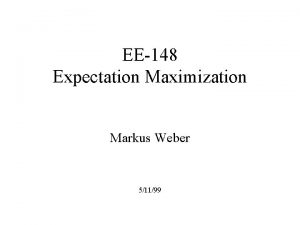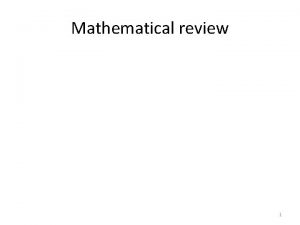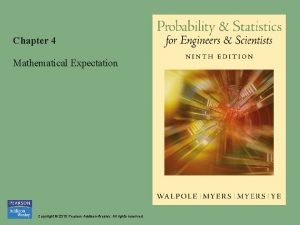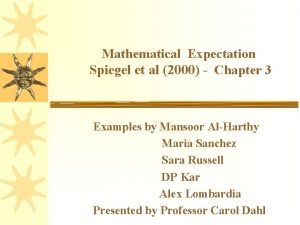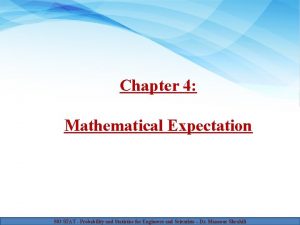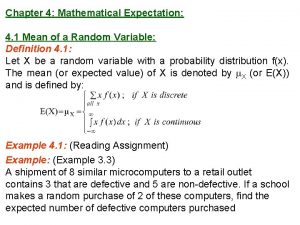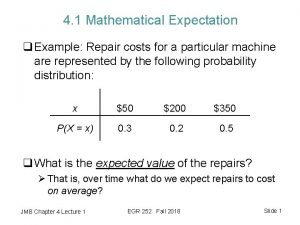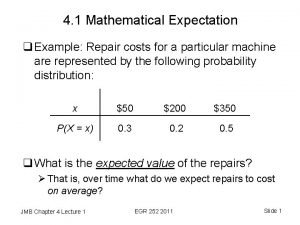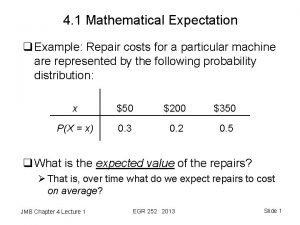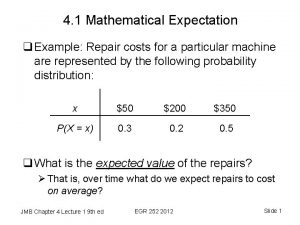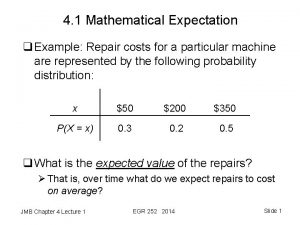Chapter 4 Mathematical Expectation 4 1 Chapter Outline





















- Slides: 21

Chapter 4 Mathematical Expectation 4 -1

Chapter Outline 4. 1 Mean of a Random Variable 4. 2 Variance of Random Variables 4. 3 Means and Variances of Linear Combinations of Random Variables 3 -2

Mean or Expected Value 4 -3

Mean or Expected Value Assuming that a fair coin was tossed twice, we find that the sample space for our experiment is S = {HH, HT, TH, TT }. Since the 4 sample points are all equally likely, it follows that P(X = 0) = P(TT) = 1/4, P(X = 1) = P(TH) + P(HT) = 1/2, P(X = 2) = P(HH) = 1/4, where a typical element, say TH, indicates that the first toss resulted in a tail followed by a head on the second toss. Now, these probabilities are just the relative frequencies for the given events in the long run. Therefore, μ = E(X) = (0)(1/4) + (1)(1/2) + (2)(1/4) = 1. This result means that a person who tosses 2 coins over and over again will, on the average, get 1 head per toss. 4 -4

Example 1 A lot containing 7 components is sampled by a quality inspector; the lot contains 4 good components and 3 defective components. A sample of 3 is taken by the inspector. Find the expected value of the number of good components in this sample. Solution: Let X represent the number of good components in the sample. The probability distribution of X is This yield f (0) = 1/35, f (1) = 12/35, f (2) = 18/35, and f (3) = 4/35. Therefore, μ = E(X) = (0)(1/35) + (1)(12/35) + (2)(18/35) + (3)(4/35) = 1. 7 Thus, if a sample of size 3 is selected at random over and over again from a lot of 4 good components and 3 defective components, it will contain, on average, 1. 7 good components. 4 -5

Example 2 Let X be the random variable that denotes the life in hours of a certain electronic device. The probability density function is Find the expected life of this type of device. Solution: we have Therefore, we can expect this type of device to last, on average, 200 hours. 4 -6

Theorem 4 -7

Example 1 Suppose that the number of cars X that pass through a car wash between 4: 00 P. M. and 5: 00 P. M. on any sunny Friday has the following probability distribution: x 4 5 6 7 8 9 P( X = x) 1 / 12 1/4 1/6 Let g(X) = 2 X − 1 represent the amount of money, in dollars, paid to the attendant by the manager. Find the attendant’s expected earnings for this particular time period. Solution: 4 -8

Example 2 Let X be a random variable with density function Find the expected value of g(X) = 4 X + 3. Solution: 4 -9

Distributions with Equal Means and Unequal Dispersions • The mean, or expected value, of a random variable X is of special importance in statistics because it describes where the probability distribution is centered. By itself, however, the mean does not give an adequate description of the shape of the distribution. We also need to characterize the variability in the distribution. • In the Figure, we have the histograms of two discrete probability distributions that have the same mean, μ = 2, but differ considerably in variability, or the dispersion of their observations about the mean. 4 - 10

Variances 4 - 11

Example 1 Let the random variable X represent the number of defective parts for a machine when 3 parts are sampled from a production line and tested. The following is the probability distribution of X. x 0 1 2 3 f(x) 0. 51 0. 38 0. 10 Calculate σ 2. Solution: First, we compute μ = (0)(0. 51) + (1)(0. 38) + (2)(0. 10) + (3)(0. 01) = 0. 61. Now, E(X 2) = (0)(0. 51) + (1)(0. 38) + (4)(0. 10) + (9)(0. 01) = 0. 87. Therefore, σ 2 = E(X 2) − μ 2 = 0. 87 − (0. 61)2 = 0. 4979. 4 - 12

Example 2 The weekly demand for a drinking-water product, in thousands of liters, from a local chain of efficiency stores is a continuous random variable X having the probability density Find the mean and variance of X. Solution: 4 - 13

Theorem 4 - 14

Example 1 Calculate the variance of g(X) = 2 X + 3, where X is a random variable with probability distribution x 0 1 2 3 f(x) 1/4 1/8 1/2 1/8 Solution: First, we find the mean of the random variable 2 X + 3 Now, we have 4 - 15

Example 2 Let X be a random variable with density function Find the variance of the random variable g(X) = 4 X + 3. Solution: 4 - 16

Theorem 4 - 17

Example 1 Suppose that the number of cars X that pass through a car wash between 4: 00 P. M. and 5: 00 P. M. on any sunny Friday has the following probability distribution: x 4 5 6 7 8 9 P( X = x) 1 / 12 1/4 1/6 Let g(X) = 2 X − 1 represent the amount of money, in dollars, paid to the attendant by the manager. Find the attendant’s expected earnings for this particular time period. Solution: 4 - 18

Example 2 Let X be a random variable with density function Find the expected value of g(X) = 4 X + 3. Solution: 4 - 19

Theorem 4 - 20

Example Let X be a random variable with density function Find the variance of the random variable g(X) = 4 X + 3. Solution: 4 - 21
 Mathematical expectation examples
Mathematical expectation examples Elements of mathematical economics
Elements of mathematical economics Topic sentence outline example
Topic sentence outline example Expectation for webinar
Expectation for webinar Expectation value of hermitian operator
Expectation value of hermitian operator Expectation value of energy in quantum mechanics
Expectation value of energy in quantum mechanics Wave reflection formula
Wave reflection formula Expectation value in quantum mechanics
Expectation value in quantum mechanics Iterated expectation
Iterated expectation Soil expectation value formula
Soil expectation value formula Teamwork problem solving
Teamwork problem solving General solution of wave equation
General solution of wave equation Prayer points on expectation
Prayer points on expectation Postulates of quantum mechanics
Postulates of quantum mechanics Irony is the contrast between expectation and reality.
Irony is the contrast between expectation and reality. What is financial expectation
What is financial expectation Expectation value
Expectation value Service level expectation
Service level expectation 3 levels of customer expectations
3 levels of customer expectations Expectation value in quantum mechanics
Expectation value in quantum mechanics Public expectations
Public expectations Dual customer expectation levels
Dual customer expectation levels
